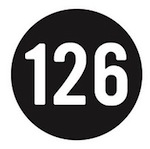126 presents:
STAGED AND SCREENED
James Brooks
The exhibition utilises high and low cultural sources from– cinema, theatre, music and television as departure points to produce a series of works in - drawing, video, print and audio. The work explores the performance-based nature of the source material, through employing processes which forefront ideas concerning time, duration and visibility, along with an audience’s relationship to Art production.
Staged and Screened in part, attempts to spotlight an audience’s role within an auditorium or public space: where to sit or stand, the etiquette of appreciation and participation- with reference to Bertolt Brecht’s writings on the subject, along with the more recent analysis within Nicolas Bourriaud’s publication Relational aesthetics. Brooks’ interventions attempt to reaffirm the viewer’s physical position in time and space as an important component, akin to Walter Benjamin’s ideas on the importance of a physical encounter with a work of art.
All the pieces in the exhibition operate with a strong sense of internal logic in relation to the source material. These ‘slight to laborious’ interventions of altering the aesthetics of the specific information are an attempt to forefront a particular aspect or observation- from the whimsical to the austere. One part of the exhibition presents a series of 31 audience seating layout drawings of New York City theatres- Seating plans of 24 ‘On’ Broadway theatres and Seating plans of 7 ‘Off ’ Broadway theatres. By presenting the crowd or audience as the artwork, Brooks is attempting to question the 20th century convention of cultural consumption by playing with an intentional disorientating inversion. Continuing the analysis of an ‘active’ or ‘passive’ engagement of an audience, the audio work- Absent friends edits out the narrative and visual content of a generic episode of the American TV series- Friends, leaving just the sporadic punctuation of canned audience laughter for its duration, which is synthetically utilised in the show’s production as a device for keeping the tempo of the sitcom. Furthermore, Brooks’ video piece- Reversed Performance appropriates the 1970’s Film – Performance, starring Mick Jagger, then at the height of his fame, in a semi-acting/ real life role. By re-filming the rewinding visuals of the thriller from the reverse of a domestic television, the narrative content of the film is lost and thus becomes an abstract light presentation, akin to music concert lighting projecting out into the audience from a stage position.
Furthermore, geographically the location of 126 in Galway is conceptually of interest to this body of work. The gallery- in turn exhibition, on the West coast of Ireland is across the Atlantic from the United States of America and more specifically New York City. Thus, this addresses on a larger cultural and geographical scale the notion of who is the symbolic ‘actor’ and who is the ‘audience’ in this particular exhibition scenario.
James Brooks was born in Devon, England in 1974. He completed his MA in Fine Art at Chelsea college of Art, London and his BA in Fine Art with 1st class honours at the University of Plymouth. To date, he has shown in International spaces in: Paris, Frankfurt, Norway and New York, along with shows in London at: Tate Britain, Seventeen, Domobaal, Arcade, Monica Bobinska gallery, Trinity Contemporary, and Riflemaker. Furthermore, he has curated a number of Arts Council funded groups shows on drawing in London and Paris, along with delivering a paper on the future of Contemporary Drawing at the National gallery in London. He lives and works in London.
Further information at: http://www.jamesbrooksdrawing.blogspot.com

